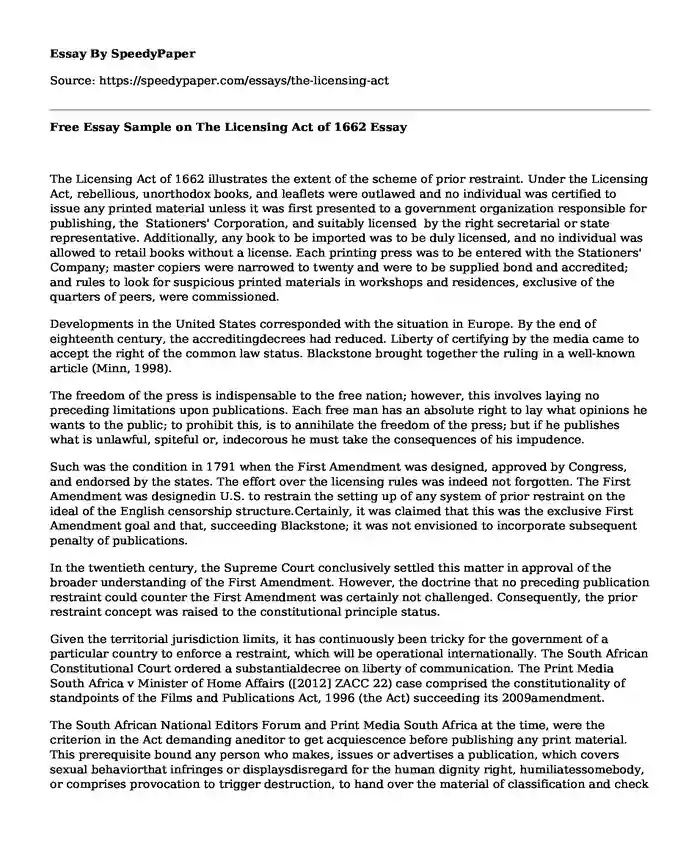
| Type of paper: | Essay |
| Categories: | License Censorship |
| Pages: | 3 |
| Wordcount: | 743 words |
The Licensing Act of 1662 illustrates the extent of the scheme of prior restraint. Under the Licensing Act, rebellious, unorthodox books, and leaflets were outlawed and no individual was certified to issue any printed material unless it was first presented to a government organization responsible for publishing, the Stationers' Corporation, and suitably licensed by the right secretarial or state representative. Additionally, any book to be imported was to be duly licensed, and no individual was allowed to retail books without a license. Each printing press was to be entered with the Stationers' Company; master copiers were narrowed to twenty and were to be supplied bond and accredited; and rules to look for suspicious printed materials in workshops and residences, exclusive of the quarters of peers, were commissioned.
Developments in the United States corresponded with the situation in Europe. By the end of eighteenth century, the accreditingdecrees had reduced. Liberty of certifying by the media came to accept the right of the common law status. Blackstone brought together the ruling in a well-known article (Minn, 1998).
The freedom of the press is indispensable to the free nation; however, this involves laying no preceding limitations upon publications. Each free man has an absolute right to lay what opinions he wants to the public; to prohibit this, is to annihilate the freedom of the press; but if he publishes what is unlawful, spiteful or, indecorous he must take the consequences of his impudence.
Such was the condition in 1791 when the First Amendment was designed, approved by Congress, and endorsed by the states. The effort over the licensing rules was indeed not forgotten. The First Amendment was designedin U.S. to restrain the setting up of any system of prior restraint on the ideal of the English censorship structure.Certainly, it was claimed that this was the exclusive First Amendment goal and that, succeeding Blackstone; it was not envisioned to incorporate subsequent penalty of publications.
In the twentieth century, the Supreme Court conclusively settled this matter in approval of the broader understanding of the First Amendment. However, the doctrine that no preceding publication restraint could counter the First Amendment was certainly not challenged. Consequently, the prior restraint concept was raised to the constitutional principle status.
Given the territorial jurisdiction limits, it has continuously been tricky for the government of a particular country to enforce a restraint, which will be operational internationally. The South African Constitutional Court ordered a substantialdecree on liberty of communication. The Print Media South Africa v Minister of Home Affairs ([2012] ZACC 22) case comprised the constitutionality of standpoints of the Films and Publications Act, 1996 (the Act) succeeding its 2009amendment.
The South African National Editors Forum and Print Media South Africa at the time, were the criterion in the Act demanding aneditor to get acquiescence before publishing any print material. This prerequisite bound any person who makes, issues or advertises a publication, which covers sexual behaviorthat infringes or displaysdisregard for the human dignity right, humiliatessomebody, or comprises provocation to trigger destruction, to hand over the material of classification and check up of the Publications and Films Board prior to releasing the publication (Wallack, 1993).
Newspapers controlled by the Press Ombudsman were exempted from the prior restraint. Any publisher who did not present the material for classification, he or she could be penalized and detained for a period of five years.
Justice ThembileSkweyiya knocked down the prior restraint as abusive to the freedom of speech. He further decreed that the criterioncould not be set aside by elucidating the classification standards: it had to be removed from the Act entirely.
The policy of prior restraint, while progressing out of pastsettings, finds its foundation today in the critical influence, which systems of prior restraint harness upon liberty of communication. The crescendos and structure of such systemsincline strongly to over-control-towards an overindulgence of order and liberty insufficiency. Prior restraint does not need a choice between law and no law. Itexcludes a specific control system, which inclines to develop anauthoritative and uncalled-for structure of government that could constrain free expression. These predispositions of prior restraint schemes are untenablecurrently in scrutiny of the evolvingdemands for defensiverules over diversekinds of communication. Therefore, the risks that presently jeopardize democratic rights in these countries approve the basic soundness of the law against prior restraint.
References
Minn. L. Rev. (1918). Freedom of Speech of the Press, 2, 239-247.
Wallack, E. J., (1983). Executive Powers of Prior Restraint over Publication of National Security Information: The UK and USA Compared.
Cite this page
Free Essay Sample on The Licensing Act of 1662. (2019, May 15). Retrieved from https://speedypaper.com/essays/the-licensing-act
Request Removal
If you are the original author of this essay and no longer wish to have it published on the SpeedyPaper website, please click below to request its removal:
Popular categories




